
COMPUTEX 2009: With ATI and Nvidia’s GPU line-up looking settled until the introduction of DirectX 11 cards towards the end of the year, the Taiwanese hardware manufacturers have been busy thinking up ways to the make current offerings more attractive.
MSI has a new power design for the GeForce GTX 260 and 275, and today we got a chance to see Asus’ new Mars high-end graphics cards in action at Computex 2009.
The Mars GTX/2DI/4GD3 is based on the GeForce GTX 295 and Asus claims it’s 21% faster than the reference board. Asus’s design features 4GB of memory – more than double the usual 1,792MB the GTX 295 usually has – which meant the dual-card system we saw at the show featured a ludicrous 8GB of video memory.
The card has been overclocked too, with the GPU running at 648MHz (up from 576MHz) and the stream processors at 1,476MHz (increased from 1,242MHz). The massive amount of memory runs considerably quicker, at 2,400MHz effective, compared to 1,998MHz for the reference card. To keep the card cool, Asus has fitted a custom cooler with eight heatpipes.
To put the card to good use, Asus put two into a test system which was running Far Cry 2 on a massive monitor. A quick trip to the game’s option screen confirmed it was running at 3,840 x 2,160 with all the eye candy on. It looked enormous and played fairly smoothly too.
The company also had a new GeForce GTX 285 on show, the Matrix GTX285/HTDI/1GD3. This card has similar speed specs to the Mars (GPU running at 648MHz GPU, stream processors clocked at 1,476MHz and 2,484MHz memory).
The cooler features an LED with five colour states indication the level of load the card is under. We were told this is purely a hardware feature and there’s no software access, so the LED isn’t going to be useful unless you have your PC on the desk. More practical was the Tracker 2 software. This allows you to overclock the card in Windows, tuning GPU and shader clocks along with voltages and memory timings, just as in a motherboard BIOS.
The software can then save your overclocked settings to the card’s BIOS so that they’re applied on start-up. Even better, if you then find your settings are making the system unstable, the card has a hidden ‘safe’ BIOS – just press the switch on the backplate and these will be restored, and all will be will with the world.

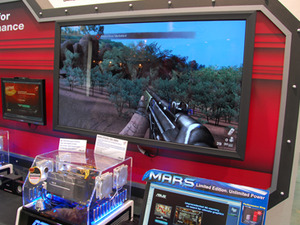
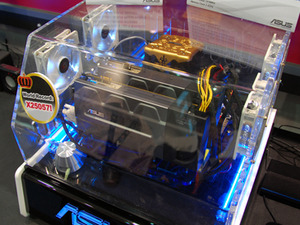
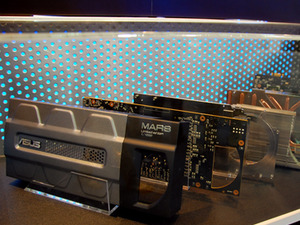
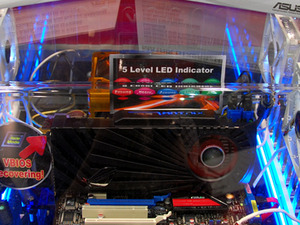


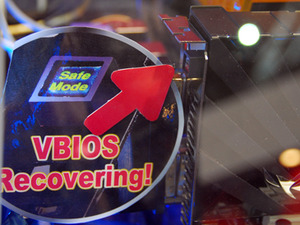
MSI has a new power design for the GeForce GTX 260 and 275, and today we got a chance to see Asus’ new Mars high-end graphics cards in action at Computex 2009.
The Mars GTX/2DI/4GD3 is based on the GeForce GTX 295 and Asus claims it’s 21% faster than the reference board. Asus’s design features 4GB of memory – more than double the usual 1,792MB the GTX 295 usually has – which meant the dual-card system we saw at the show featured a ludicrous 8GB of video memory.
The card has been overclocked too, with the GPU running at 648MHz (up from 576MHz) and the stream processors at 1,476MHz (increased from 1,242MHz). The massive amount of memory runs considerably quicker, at 2,400MHz effective, compared to 1,998MHz for the reference card. To keep the card cool, Asus has fitted a custom cooler with eight heatpipes.
To put the card to good use, Asus put two into a test system which was running Far Cry 2 on a massive monitor. A quick trip to the game’s option screen confirmed it was running at 3,840 x 2,160 with all the eye candy on. It looked enormous and played fairly smoothly too.
The company also had a new GeForce GTX 285 on show, the Matrix GTX285/HTDI/1GD3. This card has similar speed specs to the Mars (GPU running at 648MHz GPU, stream processors clocked at 1,476MHz and 2,484MHz memory).
The cooler features an LED with five colour states indication the level of load the card is under. We were told this is purely a hardware feature and there’s no software access, so the LED isn’t going to be useful unless you have your PC on the desk. More practical was the Tracker 2 software. This allows you to overclock the card in Windows, tuning GPU and shader clocks along with voltages and memory timings, just as in a motherboard BIOS.
The software can then save your overclocked settings to the card’s BIOS so that they’re applied on start-up. Even better, if you then find your settings are making the system unstable, the card has a hidden ‘safe’ BIOS – just press the switch on the backplate and these will be restored, and all will be will with the world.


Mmm, detailalicious


The Mars cooler in its full glory


On the left you can see the Asus app which allows you to tune your graphics card's memory


There's a button to revert to safe BIOS settings if the overclock goes wrong

MSI MPG Velox 100R Chassis Review
October 14 2021 | 15:04






Want to comment? Please log in.